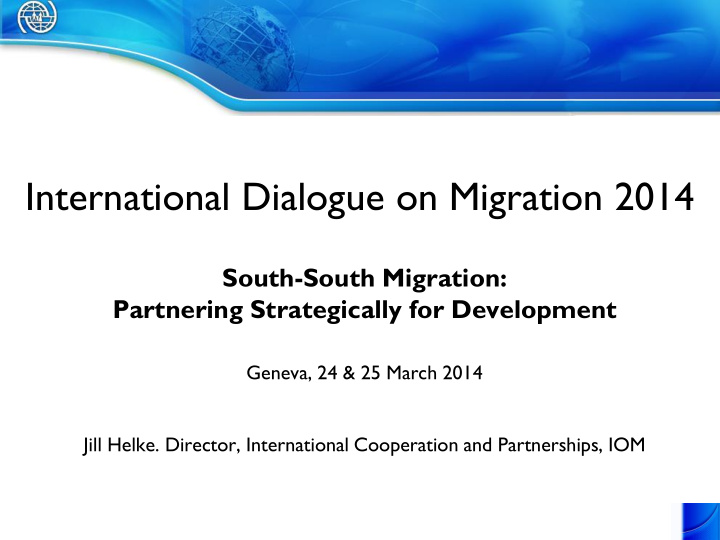



International Dialogue on Migration 2014 South-South Migration: Partnering Strategically for Development Geneva, 24 & 25 March 2014 Jill Helke. Director, International Cooperation and Partnerships, IOM
IDM 2014 • Overarching theme: “ Human mobility and development: emerging trends and new opportunities for partnerships” • 1 st Workshop (24-25 March) “ South-South migration: partnering strategically for development ” • 2 nd Workshop (7-8 October) “Migration and Families”
Emerging trends Migration still driven by economic, demographic, and other disparities… … but new growth poles are emerging in different regions and demand for migrant workers is becoming global = new & evolving migration routes and patterns, new challenges and opportunities for partnerships 3
Emerging trends Source: IOM World Migration Report 2013 4
North / South • Shorthands for complex realities • Different definitions by World Bank, UNDP, UNDESA Source: IOM World Migration Report 2013 5
Why focus on South-South migration? Scale & Complexity 1 North South South South (IOM WMR, 2013, based on 2010 data by UNDESA, WB classification) More than half of the top 20 migration corridors worldwide are along the South – South axis (IOM WMR 2013) South-South migration: intra-regional and extra-regional 6
Why focus on South-South migration? 2 Development potential 2 • Long-standing poverty reduction and livelihood strategy • Economic growth in countries of the South demand for labour at all skills levels • Significant financial remittances flows, but high transfer costs • Important social remittances and diaspora contributions • Mobility as an adaptation mechanism for environmental fluctuations 7
Why focus on South-South migration? 3 Gaps and Challenges 3 • Well-being of South-South migrants measurably poorer than for other migrants (WMR, 2013) • High levels of irregular migration; high risk of human rights violations, exploitation, unethical recruitment • Integration and reintegration • High proportion of forced migrants in the South • South most affected by climate change / environmental degradation as potential driver of migration • Lack of data and research • Lack of capacity or awareness 8
Faces of South-South migration Carlos, from Peru, Aleida from working as a doctor Nicaragua in Angola in Costa Rica Zimbabwean Mustariya from women traders Ethiopia, stranded in Zambia in Somalia 9
Opportunities for partnerships Extensive South-South regional cooperation • Regional economic communities • Regional consultative processes on migration Various degrees of facilitation of migration: From visa-free travel for certain categories to generalized free movement How to strengthen capacity and implementation? 10
Policy considerations • Build data and research on dynamics of South-South migration – esp. migrant well-being, diasporas, remittance behaviour, development impacts of South-South migration • Reduce cost of remittance transfer and expand financial inclusion • Address labour migration issues in a South-South context, incl. ethical recruitment, decent work, skills development • Build capacities at local, national, regional levels • Strengthen regional and inter-regional cooperation – esp. through RCPs and RECs • Integrate South-South migration into national and regional development strategies in the South 11
Conclusion: Thinking and acting in partnership • Deeper understanding of the complex dynamics of human mobility and their potential impact on development in a South-South context • Development plans need to include dynamics human mobility trends • Governments, the private sector, civil society, academia, migrants and diaspora associations have a role to play • Enhancing capacities and strengthening cooperation at the regional and interregional levels 12
Thank you! www.iom.int/cms/idmsouthsouthmigration 13
Recommend
More recommend